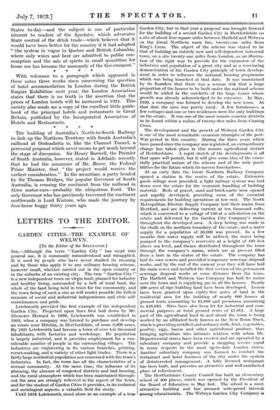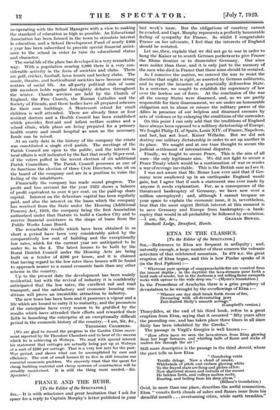LETTERS TO THE EDITOR.
GARDEN CITIES—THE EXAMPLE OF WELWYN.
[To the Editor of the SPECTATOR.]
SIR,—Although the term "Garden City" has crept into general use, it is commonly misunderstood and misapplied. It is used by people who have never studied its meaning and by those who apply it to any ordinary housing scheme, however small, whether carried out in the open country or in the suburbs of an existing city. The true "Garden City" is a new independent town on virgin land, planned for industry and healthy living, surrounded by a belt of rural land, the whole of the land being held in trust for the community, and the town being of such a size as will render possible the fullest measure of social and industrial independence and civic self- consciousness and pride.
Letchworth provided the first example of the independent Garden City. Projected upon lines first laid down by Mr. Ebenezer Howard in 1898, Letchworth was established in 1903, when a company was formed to purchase and develop an estate near Hitehin, in Hertfordshire, of some 3,800 acres. By 1921 Letchworth had become a town of over ten thousand inhabitants, with factories and workshops. Its population is largely industrial, and it provides employment for a con- siderable number of people in the surrounding villages. The industries are engineering in its various branches, printing, corset-making, and a variety of other light trades. There is a fairly large residential population not concerned with the town's industries. In fact, the town has all the characteristics of a normal community. At the same time, the influence of its planning, the absence of congested districts and bad housing, and the rural atmosphere which has been maintained through- out the area are strongly reflected in the aspect of the town, and for the student of Garden Cities it provides, in its technical and sociological aspects, a valuable field for study.
Until 1919 Letchworth stood alone as an example of a true
Garden City, but in that year a proposal was brought forward for the building of a second Garden City in Hertfordshire on a site of about four square miles between Hatfield and Welwyn on the Great Northern main line, twenty-one miles from King's Cross. The object of the scheme was stated to be that of building an entirely new and self-dependent industrial town, on a site twenty-one miles from London, as an illustra- tion of the right way to provide for the expansion of the industries and population of a great city and as a convincing demonstration of the Garden City principle of town develop- ment in order to influence the national housing programme which was being launched at that date. It was maintained by its founders that there was a serious risk that a large proportion of the houses to be built under the national scheme would be added in the outskirts of the large towns whose growth was already acknowledged to be excessive. In May, 1920, a company was formed to develop the new town. At that date the area was purely rural. A few farmhouses, a few cottages and one or two residences were the only buildings on the estate. It was one of the most remote country districts to be found within a radius of twenty-five miles from Charing Cross.
The development and the growth of Welwyn Garden City is one of the most remarkable economic triumphs of the post- War period in this country. During the three years which have passed since the company was registered, an extraordinary change has taken place in this remote agricultural district of Hertfordshire. A rapid sketch of the developments is all that space will permit, but it will give some idea of the essen- tially practical nature of the scheme and of the wide possi- bilities for the future which its success foreshadows.
At an early date the Great Northern Railway Company opened a station in the centre of the estate. Extensive goods sidings were provided, a light railway system was laid down over the estate for the economic handling of building material. Beds of gravel, sand and brick-earth were opened' and rapidly developed, providing some of the essential requirements for building operations at low cost. The North Metropolitan Electric Supply Company laid their mains from Hertford, and are delivering current at ten thousand volts, which is converted to a voltage of 240 at a sub-station on the estate and delivered by the Garden City Company's mains throughout the developed area. A deep boring was made in the chalk on the northern boundary of the estate, and a water supply for a population of 50,000 was proved. In a few months this water supply will be utilized, the water being pumped to the company's reservoirs at a height of 420 feet above sea level, and thence distributed throughout the town through the company's mains, which are at present filled from a bore in the centre of the estate. The company has laid its own sewers and provided temporary sewerage disposal works, and by the end of the current year they will have laid the main sewer and installed the first section of the permanent sewerage disposal works at some distance from the town. The Hatfield and Welwyn Gas Company has laid its mains over the town and is supplying gas to all the houses. Nearly 200 acres of ripe building land have been developed. Leases have been granted upon eighty-five acres of land in the residential area for the building of nearly 600 houses at ground rents amounting to 12,888 and premiums amounting to £26,685. Sites have also been let for industrial and com- mercial purposes at total ground rents of £1015. A large part of the agricultural land in and about the town is being worked by an affiliated body known as the New Town Trust, which is providing certified and ordinary milk, fruit, vegetables, poultry, eggs, bacon and other agricultural produce, thus bringing agriculture into intimate relation with urban life. Departmental stores have been erected and are operated by a subsidiary company and provide a shopping service equal in many respects to the most up-to-date London stores. Another subsidiary company was formed to conduct the restaurant and hotel business of the city under the system of disinterested management. A fully licensed restaurant has been built, and provides an attractive and well-conducted place of refreshment.
The Hertfordshire County Council has built an elementary school of 400 places, which was opened by the President of the Board of Education in May last. The school is a most attractive building and has aroused widespread interest- among educationists. The Welwyn Garden City Company ia
co-operating with the School Managers with a view to making the standard of education as high as possible. An Educational Association has been formed in the town to stimulate interest In education, and a School Development Fund of nearly £400 a year has been subscribed to provide special financial assist- ance to the school in order to raise its educational status and character.
The social life of the place has developed in a very remarkable way. With a population nearing 2,000 there is a very con- siderable activity in the form of societies and clubs. There are golf, cricket, football, lawn tennis and hockey clubs. The music, theatre, and horticultural societies have become strong centres of social life. An all-party political club of some 200 members holds regular fortnightly debates throughout the winter. Church services are held by the Church of England, the Free Church, the Roman Catholics and the Society of Friends, and these bodies have all prepared schemes for their own buildings. A Montessori school for small children is well attended. There are already three or four resident doctors and a Health Council has been established which provides first-aid and infant welfare centres and a school clinic, while plans are being prepared for a primary health centre and small hospital as soon as the necessary funds can be raised.
At an early date in the history of the company the estate was constituted a single civil parish. The meetings of the Parish Council are open to the public, and the interest in local affairs is well indicated by the fact that nearly 70 per cent. of the voters polled in the recent election of six additional Parish Councillors. The Parish Council possesses as one of its functions the election of three Civic Directors, who sit on the board of the company and are in a position to voice the feeling of the inhabitants.
Financially the company has made sound progress. The profit and loss account for the year 1922 shows a balance of profit equivalent to over 6 per cent. on the paid-up share capital. Interest on the debenture capital has been regularly paid, and also the interest on the loans which the company has received from the State under the Housing (Additional Powers) Act, 1919, the company being the first Association authorized under that Statute to build a Garden City and to receive financial assistance in the shape of loans from the Public Works Loan Board.
The remarkable results which have been obtained in so short a period have been very considerably aided by the comparatively low cost of building and the exceptionally low rates, which for the current year are anticipated to be under Ss. in the Z. The latest houses to be built by the Rural District Council under the Housing Acts are being built on a tender of 1286 per house, and it is claimed that having regard to the low rates these houses will be found to approach nearer to a sound economic basis than any other scheme in the country.
Up to the present date the development has been mainly residential, but with the revival of industry it is confidently anticipated that the low rates, the excellent rail and road transport, and the satisfactory and economic housing con- ditions will prove an irresistible attraction to industry.
The new town has been born and it possesses a vigour and a life which are bound to carry it to maturity, and the promoters of the enterprise have every reason to be gratified by the results which have attended their efforts and rewarded their faith in launching the enterprise at an exceptionally difficult period in the economic history of the country.—I am, Sir, &c.,
THEODORE CHAMBERS.
[We are glad to record the progress in the Garden Cities move- ment reported by Sir Theodore Chambers and to hear of th:: success which he is achieving at Welwyn. We read with special interest his statement that cottages are actually being put up at Welwyn at a cost of £286 per cottage. That is a very low rate for the post- War period, and shows what can be accomplished by care and efliciency. The cost of small houses fit to live in still remains our essential economic problem. We sincerely trust that the quest for cheap building material and cheap systems of construction will be steadily maintained. It is still the thing most needed.—En. Spectator.]















































 Previous page
Previous page